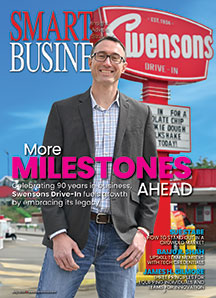After more than 25 years, DesignGroup needed a dramatic change.
The architectural design firm had been located in the suburbs in typical office space — space that just didn’t work for the creative side of the employees or for the firm’s renewed focus on teamwork.
Moving the 80-employee, $9 million company first required a look inside.
The firm’s strong suits, says CEO Robert Vennemeyer, include “sustainability,” or using less nonrenewable energy, such as fossil fuels. Instead, DesignGroup teaches its clients how to make use of renewable energy sources such as solar, wind or hydroelectric power. In addition, Vennemeyer is a strong supporter of re-use of urban land — existing sites that already have utilities and infrastructure built in.
“We can help the context and fabric of our downtown as an example for what others can do,” Vennemeyer says of his decision to build a 62,000-square-foot, five-story building at 515 E. Main St., tearing down a former rental car operation to build in its place.
The building is a joint project of DesignGroup and JDS Cos., which occupies 3,000 square feet of the space. They’ve rented out most of the rest of the building to Children’s Hospital Information Services, A-Plus Personnel Services Inc. and Kitrick and Lewis Co. LPA.
DesignGroup’s design principal, Jack Hedge, designed the $7.2 million building, which was completed in October 2000 and immediately gained local and national attention for its energy efficiency.
“We redeveloped an area already developed instead of going out to an area where they’d have to develop new streets, utilities and things like that. And because we’re in an area where things are closer together, we use less energy,” Hedge says, pointing out that employees can walk to lunch Downtown and shopping at City Center instead of using their cars.
Beyond the efficiency aspect, however, Hedge wanted to use the two floors occupied by DesignGroup to create a space not just functional and cost-saving but also fitting for the company’s culture of creativity and teamwork.
Here’s how he did it.
Be practical
Hedge’s expertise in energy-efficient design allowed DesignGroup to have a space that not only works for its culture but also for its budget.
Called “passive solar,” the building’s orientation makes the maximum use of the sun. It has a longer north/south faade than east/west, enabling its southern exposure to the sun to save energy in lighting and heating.
Sun screens on the south elevation block out undesirable summer heat gain and soak in winter sun for heat and light. The screens are placed so that in the summer, when the sun is higher, the hot rays are blocked, but in the winter, when the sun is lower, light comes straight in.
In addition, large windows on the north side maximize day lighting with minimal heat gain, and a third- and fourth-floor central atrium allows natural light to illuminate the central area of the building — a space that’s usually more like a dark dungeon in other office buildings.
Combined, the features add up to 10 to 15 percent savings in energy use.
Work together
Hedge needed to make sure the company’s new space would facilitate its teamwork culture, because each client’s work is handled by a group including project managers, designers, architects, specifications writers and other employees.
Instead of putting offices around the perimeter of the building and “worker bees,” as he says, in the center, Hedge wanted everyone in the firm to feel equally important to the teams. The result: An open interior with “pods” where each team gathers to work.
Hedge created plenty of flexible spaces, such as conference rooms with tables that can be configured to lay out large drawings or used in part as podiums for meetings.
“Nobody has an office with a door on it, but if you want to have a private conversation, there are spaces for it,” Hedge says.
Employees picked out their own office furniture, all of which is on wheels so it can be reconfigured.
“The whole point is you don’t feel so bad moving to another team,” he says.
Things used by everyone on the team, such as files or supplies, are grouped in the center of the team pods.
Designers often keep their work in progress on portable display boards.
“(An) advantage to that is you can see what the designers are working on right then,” Hedge says. “It gives everybody else some awareness of what’s going on.”
In addition, the boards can easily be wheeled into conference rooms for meetings.
The lunchroom is in the center of one of the two floors used by DesignGroup rather than stuck out of the way in a corner. Every Monday at lunch, designers take the pieces they’re working on to get input from others.
“A designer in a vacuum,” Hedge points out, “is usually not a good designer.”
Get creative
Designers, of course, need a space that inspires them to do their work, so Hedge had yet another goal to accomplish.
First, designers have options to personalize their office space. For example, interior design schemes enable them to change the paint on certain walls, rather than an entire room, whenever the desire arises.
In addition, an abundance of windows keeps employees aware of the world outside.
“Some people would think that’s a distraction. Well, I don’t think it is. I think it’s a connection, a variety,” Hedge says.
Another plus to the 10-foot high windows is they let in plenty of natural light.
“Even on a dismal day in here, at least you know it’s a dismal day. On a sunny day, it’s just glorious,” he says. “What we’re hoping the building will do is get people energized about being creative.” How to reach: DesignGroup, 225-0515 or www.dgcolumbus.com; Jack Hedge;[email protected]; Robert Vennemeyer, [email protected]
Joan Slattery Wall ([email protected]) is senior editor of SBN Magazine in Columbus.

